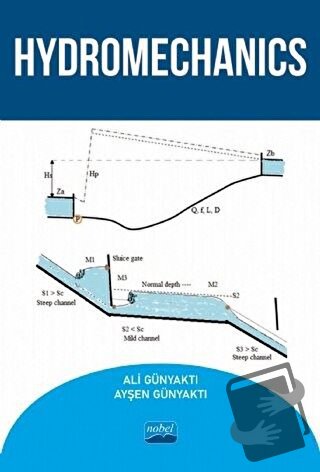
Hydromechanics text is mainly used by the undergraduate civil engineering students. It includes small amount of theory but a large amount of application of the conservation principles to the problems related with hydromechanics. Water is essential for human being, animals, vegetation, and wild life. They use water mainly for drinking, cleaning, irrigation, energy production, recreation, and watering the livestock. About 70 percent of the fresh water is used for irrigation purposes in Turkey. However, fresh water resources are commonly far away from the location where it is needed. Therefore, the transfer of water is a must between such two locations. The transfer of water from the source point to the required position is performed by means of closed conduits under pressure or open channels having free surface under atmospheric pressure. Water transportation in pipe systems may include pumps or turbines and some control apparatus which must be encountered in energy equations. This book uses the basic principles of the Fluid Mechanics for the design of the closed conduits and open channel systems necessary for the transfer of water between two points. Many solved examples are supplied for better understanding the way of using the theory explained in each chapter. There are also many problems at the end of each chapter similar to the examples supplied beforehand. They may be solved as homework by the students or to check their knowledge about the explained theory in each chapter.
| Taksit Sayısı | Taksit tutarı | Genel Toplam |
|---|---|---|
| Tek Çekim | 208,25 | 208,25 |
| 3 | 75,86 | 227,58 |
| 6 | 40,05 | 240,30 |
| 9 | 28,12 | 253,04 |
| 12 | 22,15 | 265,75 |
| Taksit Sayısı | Taksit tutarı | Genel Toplam |
|---|---|---|
| Tek Çekim | 208,25 | 208,25 |
| 3 | 75,86 | 227,58 |
| 6 | 40,05 | 240,30 |
| 9 | 28,12 | 253,04 |
| 12 | 22,15 | 265,75 |
| Taksit Sayısı | Taksit tutarı | Genel Toplam |
|---|---|---|
| Tek Çekim | 208,25 | 208,25 |
| 3 | 75,86 | 227,58 |
| 6 | 40,05 | 240,30 |
| 9 | 28,12 | 253,04 |
| 12 | 22,15 | 265,75 |
| Taksit Sayısı | Taksit tutarı | Genel Toplam |
|---|---|---|
| Tek Çekim | 208,25 | 208,25 |
| 3 | 75,86 | 227,58 |
| 6 | 40,05 | 240,30 |
| 9 | 28,12 | 253,04 |
| 12 | 22,15 | 265,75 |
| Taksit Sayısı | Taksit tutarı | Genel Toplam |
|---|---|---|
| Tek Çekim | 208,25 | 208,25 |
| 3 | 75,86 | 227,58 |
| 6 | 40,05 | 240,30 |
| 9 | 28,12 | 253,04 |
| 12 | 22,15 | 265,75 |
| Taksit Sayısı | Taksit tutarı | Genel Toplam |
|---|---|---|
| Tek Çekim | 208,25 | 208,25 |
| 3 | 75,86 | 227,58 |
| 6 | 40,05 | 240,30 |
| 9 | 28,12 | 253,04 |
| 12 | 22,15 | 265,75 |
| Taksit Sayısı | Taksit tutarı | Genel Toplam |
|---|---|---|
| Tek Çekim | 208,25 | 208,25 |
| 3 | - | - |
| 6 | - | - |
| 9 | - | - |
| 12 | - | - |
Hydromechanics text is mainly used by the undergraduate civil engineering students. It includes small amount of theory but a large amount of application of the conservation principles to the problems related with hydromechanics. Water is essential for human being, animals, vegetation, and wild life. They use water mainly for drinking, cleaning, irrigation, energy production, recreation, and watering the livestock. About 70 percent of the fresh water is used for irrigation purposes in Turkey. However, fresh water resources are commonly far away from the location where it is needed. Therefore, the transfer of water is a must between such two locations. The transfer of water from the source point to the required position is performed by means of closed conduits under pressure or open channels having free surface under atmospheric pressure. Water transportation in pipe systems may include pumps or turbines and some control apparatus which must be encountered in energy equations. This book uses the basic principles of the Fluid Mechanics for the design of the closed conduits and open channel systems necessary for the transfer of water between two points. Many solved examples are supplied for better understanding the way of using the theory explained in each chapter. There are also many problems at the end of each chapter similar to the examples supplied beforehand. They may be solved as homework by the students or to check their knowledge about the explained theory in each chapter.













